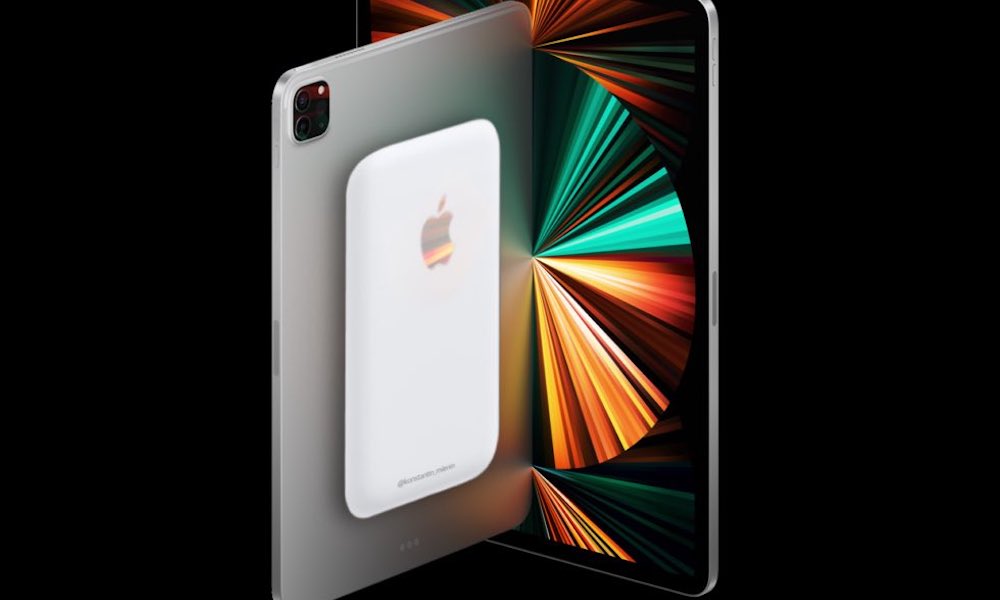Apple’s Allegedly Facing Challenges Adding Wireless Charging to iPad Pro
 Credit: Konstantin Milenin / Twitter
Credit: Konstantin Milenin / Twitter
Toggle Dark Mode
With Apple’s eager embrace of wireless charging for the iPhone, it’s been reasonable to assume that the technology will eventually come to its iPad lineup as well. However, it turns out this isn’t as simple as you might think.
We’ve been hearing solid reports since last spring that Apple isn’t just working on basic one-way wireless charging, but that the company is also hoping to add reverse wireless charging, allowing an iPhone or a set of AirPods to be juiced back up from an iPad Pro.
It’s a feature that makes sense with the iPad’s larger battery capacity, but there’s still one important obstacle that’s quite literally getting in the way of wireless charging: the iPad’s metal back.
Since Qi wireless charging uses magnetic induction to deliver power to a device’s battery, it naturally doesn’t work through metal. Even the lightweight aluminum design of the iPad Pro is enough to interfere with standard wireless charging signals, and it definitely doesn’t lend itself to Apple’s MagSafe technology.
This is why the iPhone switched to glass for the back when wireless charging debuted in 2017, and the consensus has been that this year’s iPad Pro would do the same, but it turns out that may not be the case.
A new report from 9to5Mac’s Filipe Espósito reveals that Apple’s designers aren’t too keen on the idea of going with an entirely glass back on the iPad, since it would make the product considerably more fragile.
The larger surface area of the iPad would make it more prone to damage, and of course many users also handle and use an iPad very differently from how they use an iPhone.
According to 9to5Mac’s sources, there’s a good chance that Apple has already prototyped and abandoned the rumoured glass design as an unacceptable compromise; however, that doesn’t mean it’s given up on wireless charging — it’s simply trying a more novel approach.
Sources say that Apple is now working with prototypes with an aluminum back surrounding a larger Apple logo that’s made from glass.
Espósito notes that the logo would be similar in size to what’s found on the new MacBook Pro — large enough to accommodate a standard MagSafe ring and pass power through from a wireless charger into the iPad Pro’s internal circuitry.
The prototype is also reportedly using stronger magnets to ensure a more secure hold, which is understandably necessary considering the larger size and weight of the iPad Pro, and the greater likelihood that it would be used while attached to a MagSafe charger.
Apple is also working on providing even faster charging speeds to the iPad Pro than the 15W that MagSafe is currently capable of delivering.
That would undoubtedly require a new lineup of MagSafe chargers to accommodate the faster speeds, although it sounds like these will be specific to the iPad, at least for now.
Since MagSafe uses the Qi wireless charging standard, it’s likely that the new iPad Pro would still be capable of charging from any Qi charger, as well as Apple’s current MagSafe chargers for the iPhone. A newer charger would simply be required to deliver the fastest possible wireless charging speeds.
It’s also unlikely we’ll see a port-less iPad Pro anytime soon, and of course wired USB-C charging will continue to be an option for the foreseeable future. It’s unclear from the current crop of rumours if Apple plans to try to get MagSafe charging speeds to match wired charging speeds.
The 2022 iPad Pro will also likely gain the M2 chip that’s expected to arrive in this year’s redesigned MacBook Air and upgraded entry-level 14-inch MacBook Pro, while packing in a larger battery and possibly even the camera module from the iPhone 13. Sources also confirm other recent reports that Apple is still prototyping iPad Pro models with even larger displays, although these aren’t likely to arrive this year.
Along the same lines, Apple is also experimenting with adding a notch to the iPad Pro display to shrink the bezels even further and match the design language of the new MacBook Pro, but there’s been no decision yet on whether it’s actually going to go in that direction.
[The information provided in this article has NOT been confirmed by Apple and may be speculation. Provided details may not be factual. Take all rumors, tech or otherwise, with a grain of salt.]






